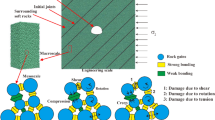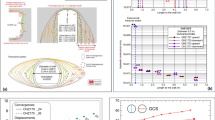Abstract
The disposal of highly radioactive spent nuclear fuel in deep geological media will require excavating a large number of galleries in low-permeable rocks, altering initial rock integrity at the repository site. The FE tunnel excavated in Opalinus Clay at the Mont Terri Underground Research Laboratory (Switzerland) is a unique full-scale experiment to study this process. We conducted a numerical study of the excavation of the FE tunnel in a coupled hydro-mechanical finite element framework, employing an anisotropic plasticity coupled with damage constitutive model. A second gradient of dilatancy formulation is employed to avoid spurious mesh-dependent behavior originating from the softening of the coupled damage-plasticity model. The approach is validated by comparing numerical predictions and in situ observations during and after tunnel excavation in terms of displacements, pore water pressure evolution and degradation of elasticity. Mechanical parameters are calibrated using laboratory experiments and values available in the literature. The model well reproduces the coupled hydro-mechanical processes induced by excavation, giving a good agreement between numerical predictions and experimental in situ monitoring data. Furthermore, the evolution of the excavation damaged zone is correctly predicted. Thus, this modeling approach is suitable for the purpose of simulating tunnel excavation in low-permeable anisotropic quasi-brittle shales.








Similar content being viewed by others
References
Ambrose J (2014) Failure of Anisotropic Shales under Triaxial Stress Conditions. Ph.D. Thesis, Imperial College London
Bock H (2009) RA experiment: updated review of the rock mechanics properties of the opalinus clay of the Mont Terri URL based on Laboratory and Field Testing. Mont Terri Project, Technical Report 2008-04. swisstopo, Seftigenstrasse 264, 3084 Wabern, Switzerland. http://www.swisstopo.ch
Boidy E, Bouvard A, Pellet F (2002) Back analysis of time-dependent behaviour of a test gallery in claystone. Tunn Undergr Sp Technol 17:415–424
Bossart P, Thury M (2007) Research in the Mont Terri Rock laboratory: quo vadis? Phys Chem Earth Parts A/B/C 32:19–31
Bossart P, Meier PM, Moeri A, Trick T, Mayor J-C (2002) Geological and hydraulic characterisation of the excavation disturbed zone in the Opalinus Clay of the Mont Terri Rock Laboratory. Eng Geol 66:19–38
Bossart P, Bernier F, Birkholzer J, Bruggeman C, Connoll P, Dewonck S, Fukaya M, Herfor M, Jensen M, Matray J-M, Mayor JC, Moeri A, Oyama T, Schuster K, Shigeta N, Vietor T, Wieczorek K (2018) Mont Terri rock laboratory, 20 years of research: introduction, site characteristics and overview of experiments. Swiss J Geosci 110(1):3–22
Carranza-Torres C, Fairhurst C (1999) The elasto-plastic response of underground excavations in rock masses that satisfy the Hoek–Brown failure criterion. Int J Rock Mech Min 36:777–809
Chen L, Shao JF, Zhu QZ, Duveau G (2012) Induced anisotropic damage and plasticity in initially anisotropic sedimentary rocks. Int J Rock Mech Min Sci 51:13–23
Daneluzzi R, Burrus F, Küttel T, 2013. Pilot Project FE, Gallery: Execution of the FE Gallery. Mont Terri Technical Note TN 2013–103, swisstopo, Seftigenstrasse 264, 3084 Wabern, Switzerland. http://www.swisstopo.ch. http://www.mont-terri.ch
Detournay E, Cheng AH-D (1988) Poroelastic response of a borehole in a non-hydrostatic stress field. Int J Rock Mech Min Sci Geomech Abstr 25(3):171–182
Favero V, Ferrari A, Laloui L (2016) On the hydro-mechanical behaviour of remoulded and natural Opalinus Clay Shale. Eng Geol 208:128–135
Feiveson H, Mian Z, Ramana M, von Hippel F (2011) Managing nuclear spent fuel: policy lessons from a 10-country study. Bull At Sci. Available at: https://www.thebulletin.org/webedition/features/managing-nuclear-spent-fuelpolicy-lessons-10-country-study
Fernandes R (2009) Modélisation numérique objective des problèmes hydromécaniques couplés dans le cas des géomatériaux. Ph.D. thesis Ecole doctorale Université Jean Fourier (Grenoble1)
Fernandes R, Chavant C, Chambon R (2008) A simplified second gradient model for dilatant materials: theory and numerical implementation. Int J Solids Struct 45:5289–5307
Fortsakis P, Nikas K, Marinos V, Marinos P (2012) Anisotropic behaviour of stratified rock masses in tunnelling. Eng Geol 141:74–83
Foucault A, Voldoire F, Modaressi A (2011) On the numerical implementation of a multi-mechanism cyclic plasticity model associated to a dilation second gradient model aiming strain localization mitigation. 9th International work-shop on bifurcation and degradation in geomaterials. 2011. Porquerolles, France, pp 23–26
Gens A, Vaunat J, Garitte B, Wileveau Y (2007) In situ behaviour of a stiff layered clay subject to thermal loading: observations and interpretation. Géotechnique 57(2):207–228
Gräsle W, Plischke I (2007) LT experiment: Strength and deformation of Opalinus Clay. Unpublished Mont Terri Technical Report, 5
Gräsle W, Plischke I (2010) Laboratory Testing (LT) Experiment: Mechanical Behavior of Opalinus Clay, Final report from Phases 6–14. Mont Terri Technical Note TN 2009-07. swisstopo, Seftigenstrasse 264, 3084 Wabern, Switzerland. https://www.swisstopo.ch, https://www.mont-terri.ch
Grassl P, Jirásek M (2006) Damage-plastic model for concrete failure. Int J Solids Struct 43(22):7166–7196
Guéguen Y, Boutéca M (1999) Mechanical properties of rocks: pore pressure and scale effects. Oil Gas Sci Technol 54.6:703–714
Haghighat E, Pietruszczak S (2015) On the mechanical and hydraulic response of sedimentary rocks in the presence of discontinuities. Geomech Energy Environ 4:61–72
Jaeggi D, Wymann L, Burrus F, Becker J, P, B., 2014. FE-E (EDZ-characterization in the vicinity of the FE-gallery) Experiment Synthesis of the excavation damaged zone (EDZ) (Draftversion). Mont Terri Technical Note TN 2014-33. swisstopo, Seftigenstrasse 264, 3084 Wabern, Switzerland. http://www.swisstopo.ch, http://www.mont-terri.ch
Jahns E (2013) Geomechanical laboratory tests on Opalinus Clay cores from the bore hole Schlattingen SLA-1. Nagra Work Report NAB
Lemaitre J, Chaboche J-L, Benallal A, Desmorat R (2009) Mécanique des matériaux solides-3rd edition. Dunod
Levasseur S, Charlier R, Frieg B, Collin F (2010) Hydro-mechanical modelling of the excavation damaged zone around an underground excavation at Mont Terri Rock Laboratory. Int J Rock Mech Min 47:414–425
Lisjak A, Grasselli G, Vietor T (2014) Continuum–discontinuum analysis of failure mechanisms around unsupported circular excavations in anisotropic clay shales. Int J Rock Mech Min 65:96–115
Lisjak A, Garitte B, Grasselli G, Müller H, Vietor T (2015) The excavation of a circular tunnel in a bedded argillaceous rock (Opalinus Clay): short-term rock mass response and FDEM numerical analysis. Tunn Undergr Space Technol 45:227–248
Mánica M, Gens A, Vaunat J, Ruiz DF (2017) A time-dependent anisotropic model for argillaceous rocks. Application to an underground excavation in Callovo-Oxfordian claystone. Comput Geotech 85:341–350
Martin C, Lanyon G (2003) Measurement of in-situ stress in weak rocks at Mont Terri Rock Laboratory, Switzerland. Int J Rock Mech Min 40:1077–1088
Pardoen B, Seyedi D, Collin F (2015) Shear banding modelling in cross-anisotropic rocks. Int J Solids Struct 72:63–87
Parisio F (2016) Constitutive and numerical modeling of anisotropic quasi-brittle shales. Ph.D. thesis, École Polytechnique Fédérale de Lausanne, EPFL, Switzerland
Parisio F, Laloui L (2017) Plastic-damage modeling of saturated quasi-brittle shales. Int J Rock Mech Min Sci 93:295–306
Parisio F, Laloui L (2018) On the formulation of anisotropic-polyaxial failure criteria: a comparative study. Rock Mech Rock Eng 51(2):479–489
Parisio F, Samat S, Laloui L (2015) Constitutive analysis of shale: a coupled damage plasticity approach. Int J Solids Struct 75–76:88–98
Pietruszczak S, Mroz Z (2000) Formulation of anisotropic failure criteria incorporating a microstructure tensor. Comput Geotech 26:105–112
Pietruszczak S, Mroz Z (2001) On failure criteria for anisotropic cohesive-frictional materials. Int J Numer Anal Methods 25:509–524
Plassart R, Fernandes R, Giraud A, Hoxha D, Laigle F (2013) Hydromechanical modelling of an excavation in an underground research laboratory with an elastoviscoplastic behaviour law and regularization by second gradient of dilation. Int J Rock Mech Min 58:23–33
Rutqvist J (2015) Fractured rock stress-permeability relationships from in situ data and effects of temperature and chemical-mechanical couplings. Geofluids 15:48–66
Rutqvist J, Stephansson O (2003) The role of hydromechanical coupling in fractured rock engineering. Hydrogeol J 11:7–40
Rutqvist J, Chen F, Birkholzer J, Liu H-H, Müller H, Garitte B, Vietor T (2013) Modeling of coupled thermo-hydro-mechanical processes at Mont Terri heater experiment in Opalinus Clay, using TOUGH-FLAC. In: Proceedings of the 2013 international high-level radioactive conference (IHLRWM)
Sánchez M, Gens A, Olivella S (2012) THM analysis of a large-scale heating test incorporating material fabric changes. Int J Num Anal Methods Geomech 36(4):391–421
Sarris E, Papanastasiou P (2013) Numerical modeling of fluid-driven fractures in cohesive poroelastoplastic continuum. Int J Numer Anal Methods Geomech 37(12):1822–1846
Seyedi DM, Armand G, Noiret A (2017) “Transverse Action”—a model benchmark exercise for numerical analysis of the Callovo-Oxfordian claystone hydromechanical response to excavation operations. Comput Geotech 85:287–305
Shao H, Schuster K, Sönnke J, Bräuer V (2008) EDZ development in indurated clay formations–In situ borehole measurements and coupled HM modelling. Phys Chem Earth Parts A/B/C 33:S388–S395
Thury M, Bossart P (1999) The Mont Terri rock laboratory, a new international research project in a Mesozoic shale formation, in Switzerland. Eng Geol 52:347–359
Trick T, Gräfe K, Rösli U (2013) FE-A experiment: WP3: Multi-Packer-System (MPS) installed in BFE-A002, BFE-A003, BFE-A004, BFE-A005, BFE-A006 and BFE-A007; Data trend report after one year. Mont Terri Technical Note TN 2012-19. swisstopo, Seftigenstrasse 264, 3084 Wabern, Switzerland. http://www.swisstopo.ch, http://www.mont-terri.ch
Tsang C-F, Bernier F, Davies C (2005) Geohydromechanical processes in the excavation damaged zone in crystalline rock, rock salt, and indurated and plastic clays—in the context of radioactive waste disposal. Int J Rock Mech Min 42:109–125
Tsang C-F, Barnichon J, Birkholzer J, Li XL, Liu H, Sillen X (2012) Coupled thermo-hydro-mechanical processes in the near field of a high-level radioactive waste repository in clay formations. Int J Rock Mech Min 49:31–44
Vilarrasa V, Koyama T, Neretnieks I, Jing L (2011) Shear-induced flow channels in a single rock fracture and their effect on solute transport. Transp Porous Med 87:503–523
Vilarrasa V, Makhnenko R, Laloui L (2015) Influence of poromechanical and thermal properties of the caprock on the safety of CO2 storage. In: Second EAGE workshop on geomechanics and energy
Vogt T, Müller H, Garitte B, Sakaki T, Vietor T (2013) Excavation induced hydraulic response of opalinus clay-investigations of the FE-experiment at the Mont Terri URL in Switzerland, AGU fall meeting abstracts, p 1276
Wileveau Y (2005) THM behaviour of host rock (HE-D) experiment: progress report. Part 1, Technical Report TR 2005-03. Mont Terri Project. swisstopo, Seftigenstrasse 264, 3084 Wabern, Switzerland. http://www.swisstopo.ch, http://www.mont-terri.ch
Acknowledgements
The authors wish to thank the Swiss Federal Office of Topography (swisstopo), the Swiss Federal Nuclear Safety Inspectorate ENSI and the Mont Terri Project for financing this work. The authors wish to thank Dr. Paul Bossart and Dr. David Jäggi of swisstopo and Dr. Werner Gräsle of BGR, Germany, for providing data concerning the excavation of the FE tunnel as well as precious insights into the behavior of Opalinus Clay at the field and laboratory scale. The authors would also like to thank Dr. Sylvie Granet, Dr. Roméo Fernandes and Dr. Simon Raude of EDF (Électricité de France) for their important suggestions and clarifications related to the tunnel excavation procedure in Code_Aster.
Author information
Authors and Affiliations
Corresponding author
Additional information
Publisher’s Note
Springer Nature remains neutral with regard to jurisdictional claims in published maps and institutional affiliations.
Rights and permissions
About this article
Cite this article
Parisio, F., Vilarrasa, V. & Laloui, L. Hydro-mechanical Modeling of Tunnel Excavation in Anisotropic Shale with Coupled Damage-Plasticity and Micro-dilatant Regularization. Rock Mech Rock Eng 51, 3819–3833 (2018). https://doi.org/10.1007/s00603-018-1569-z
Received:
Accepted:
Published:
Issue Date:
DOI: https://doi.org/10.1007/s00603-018-1569-z




